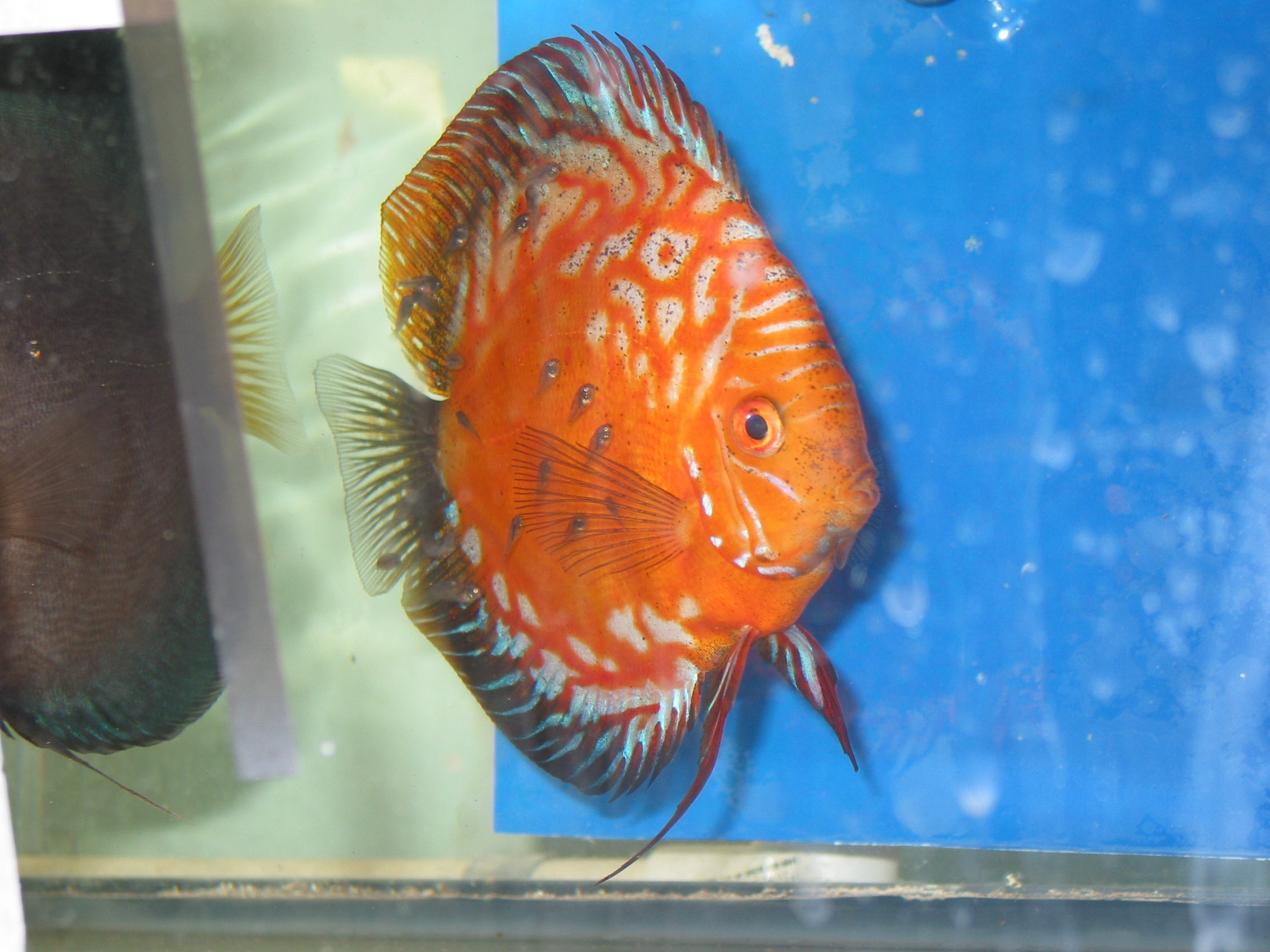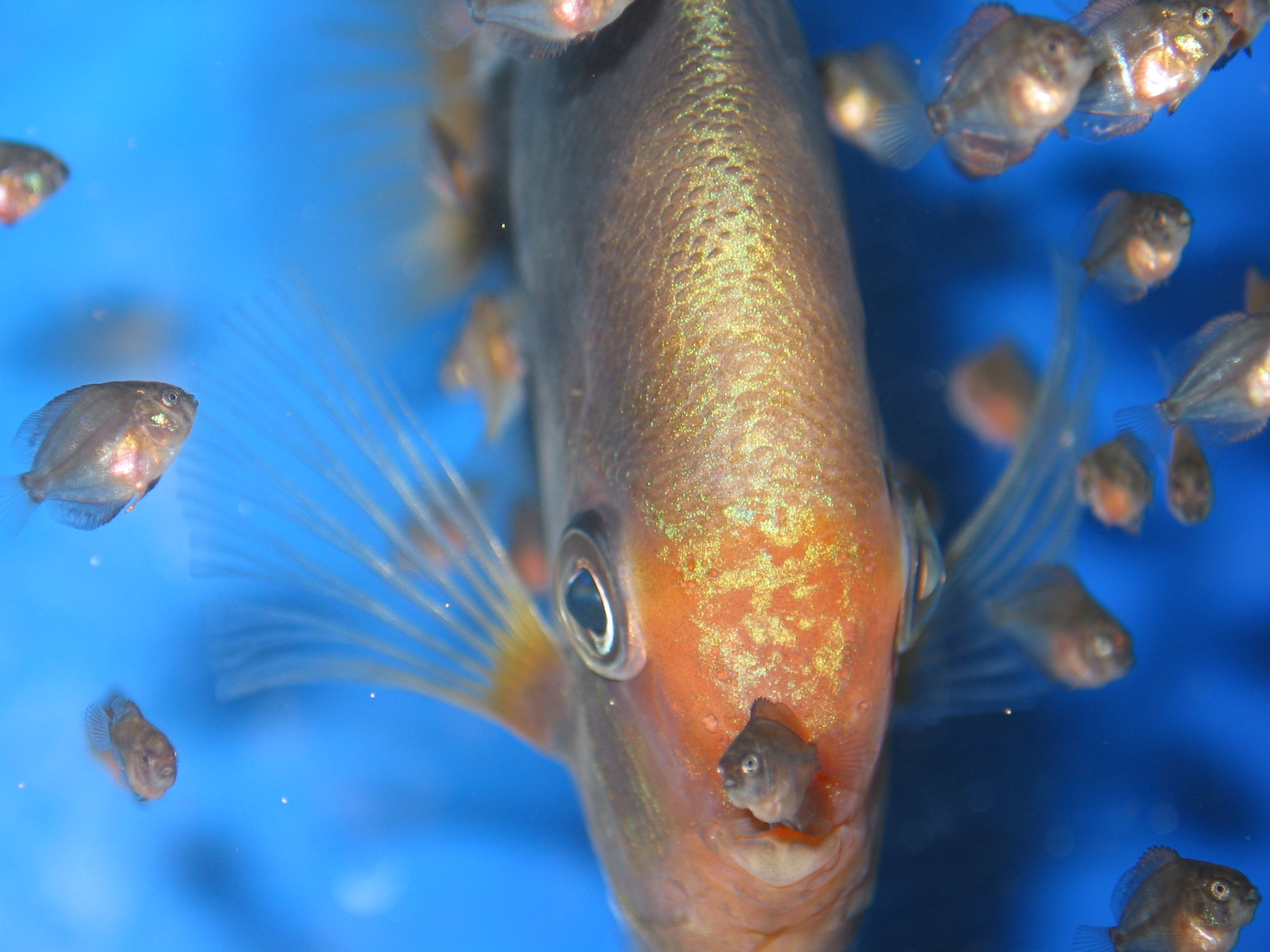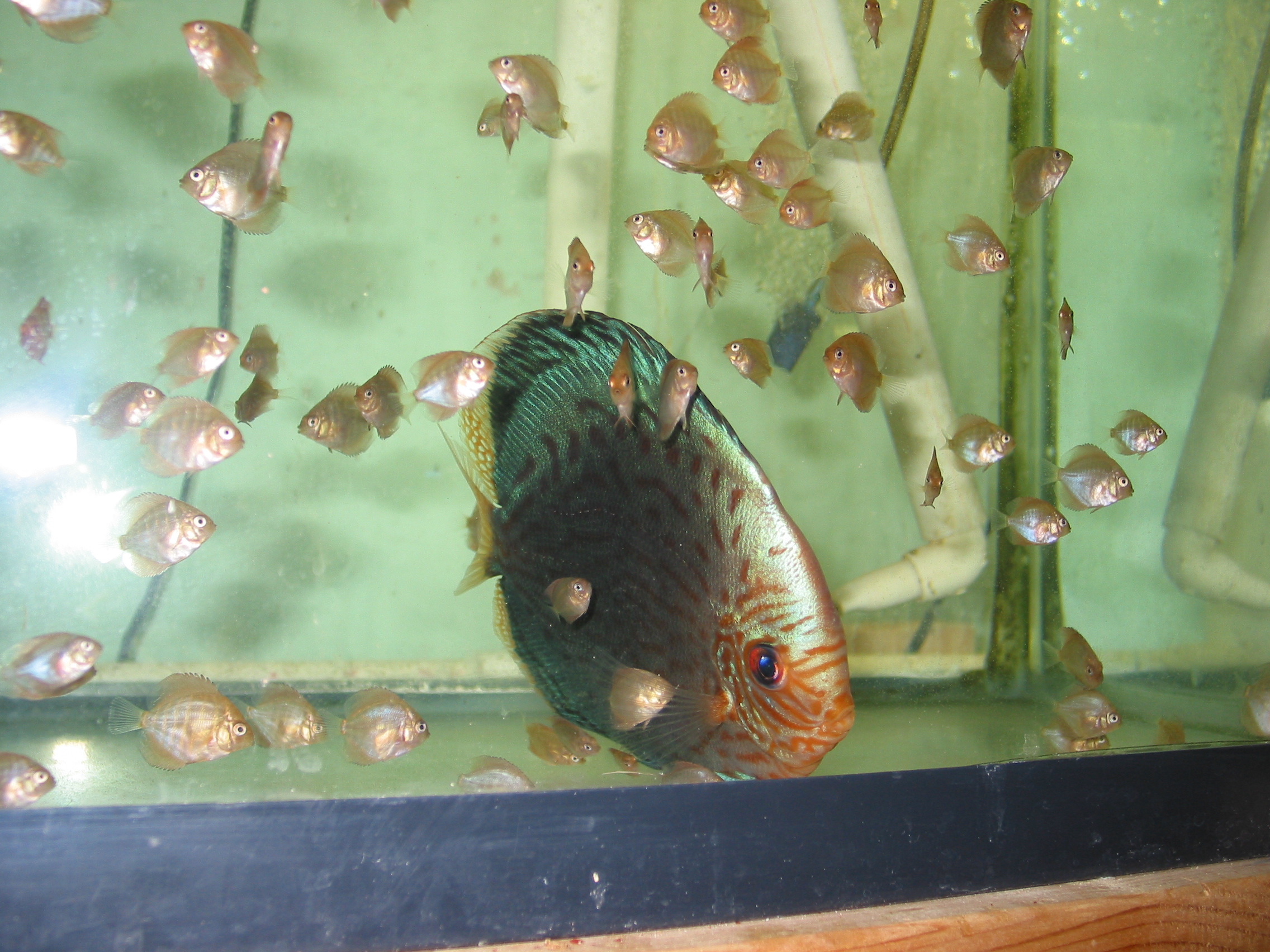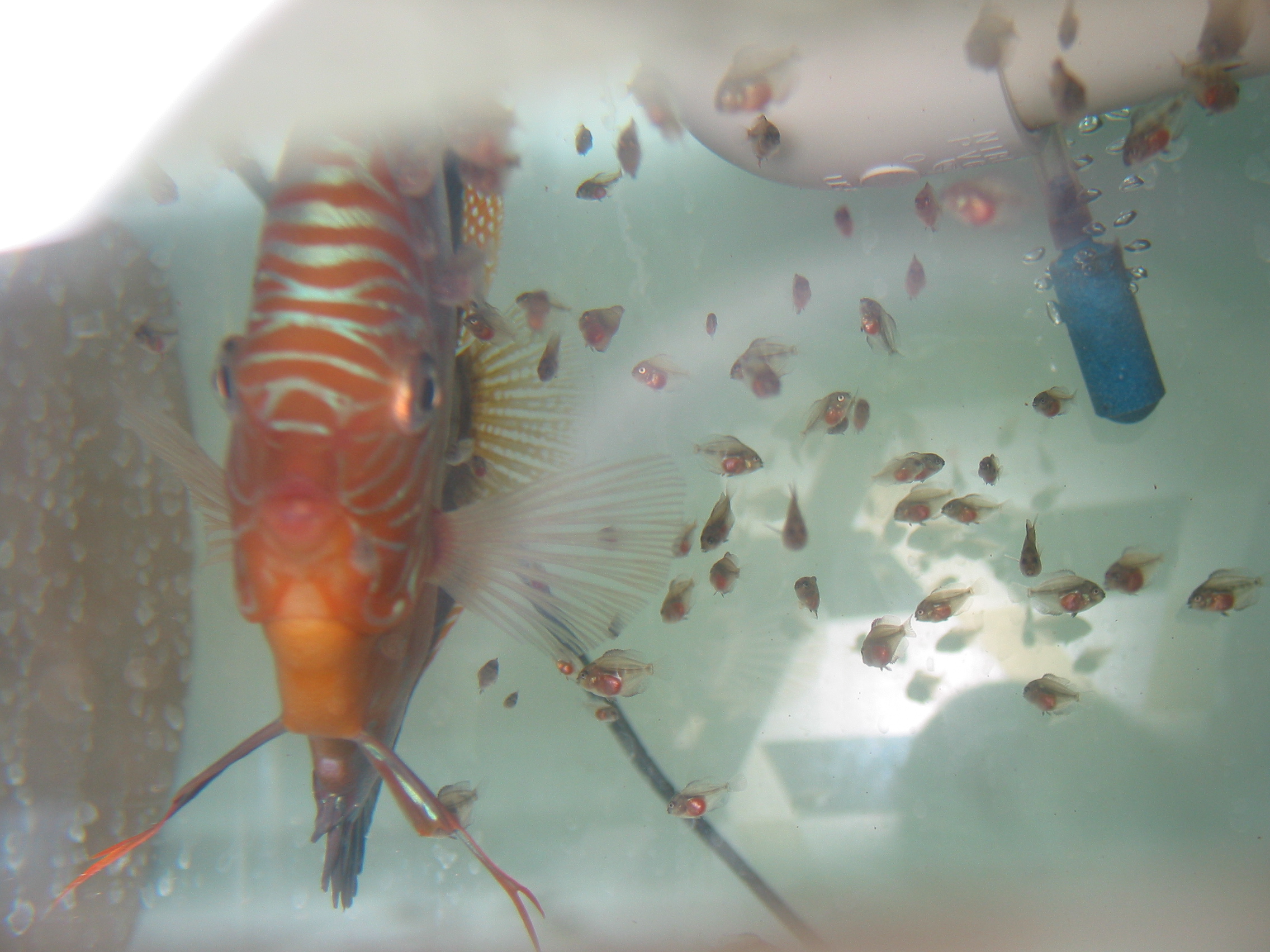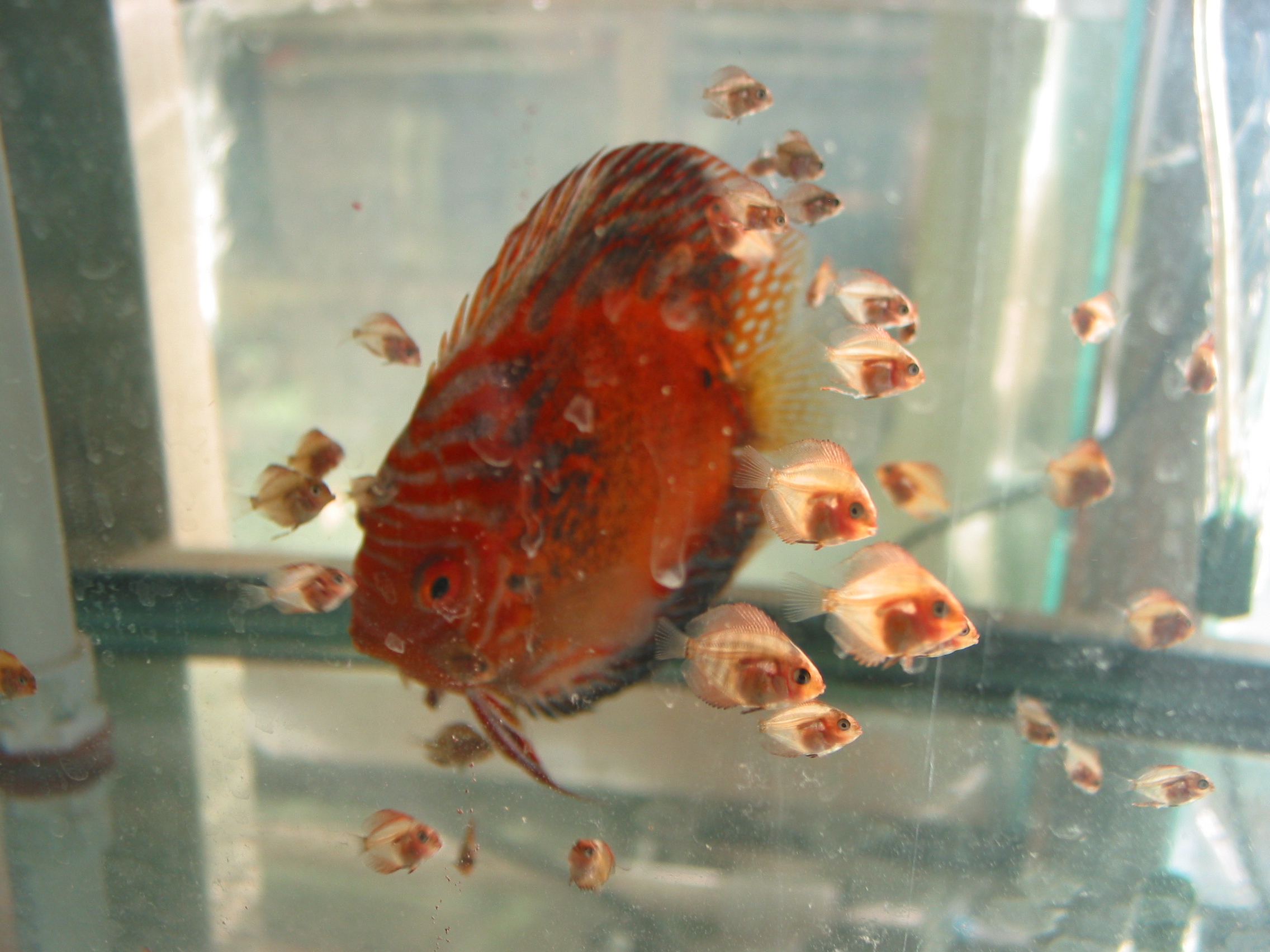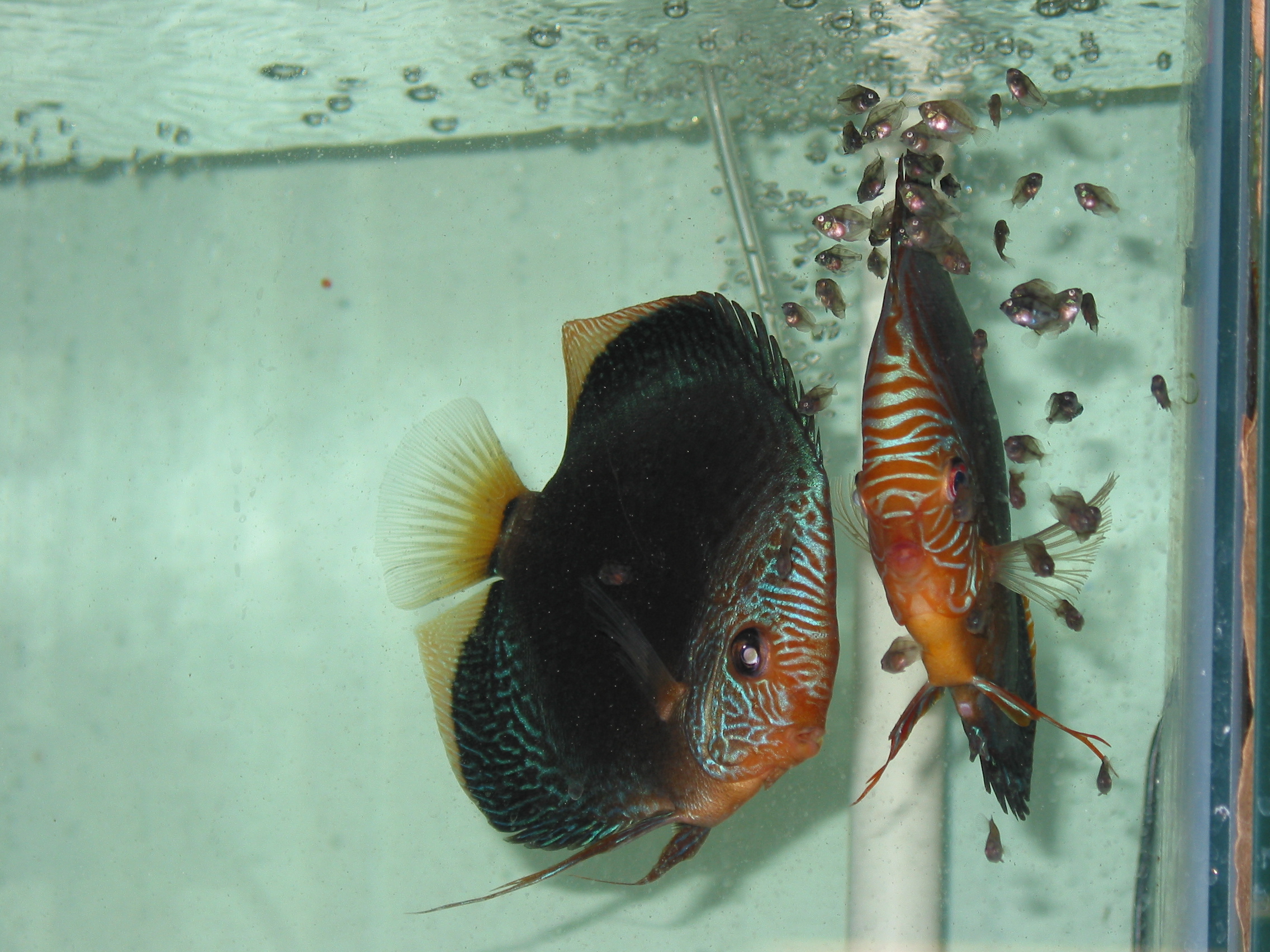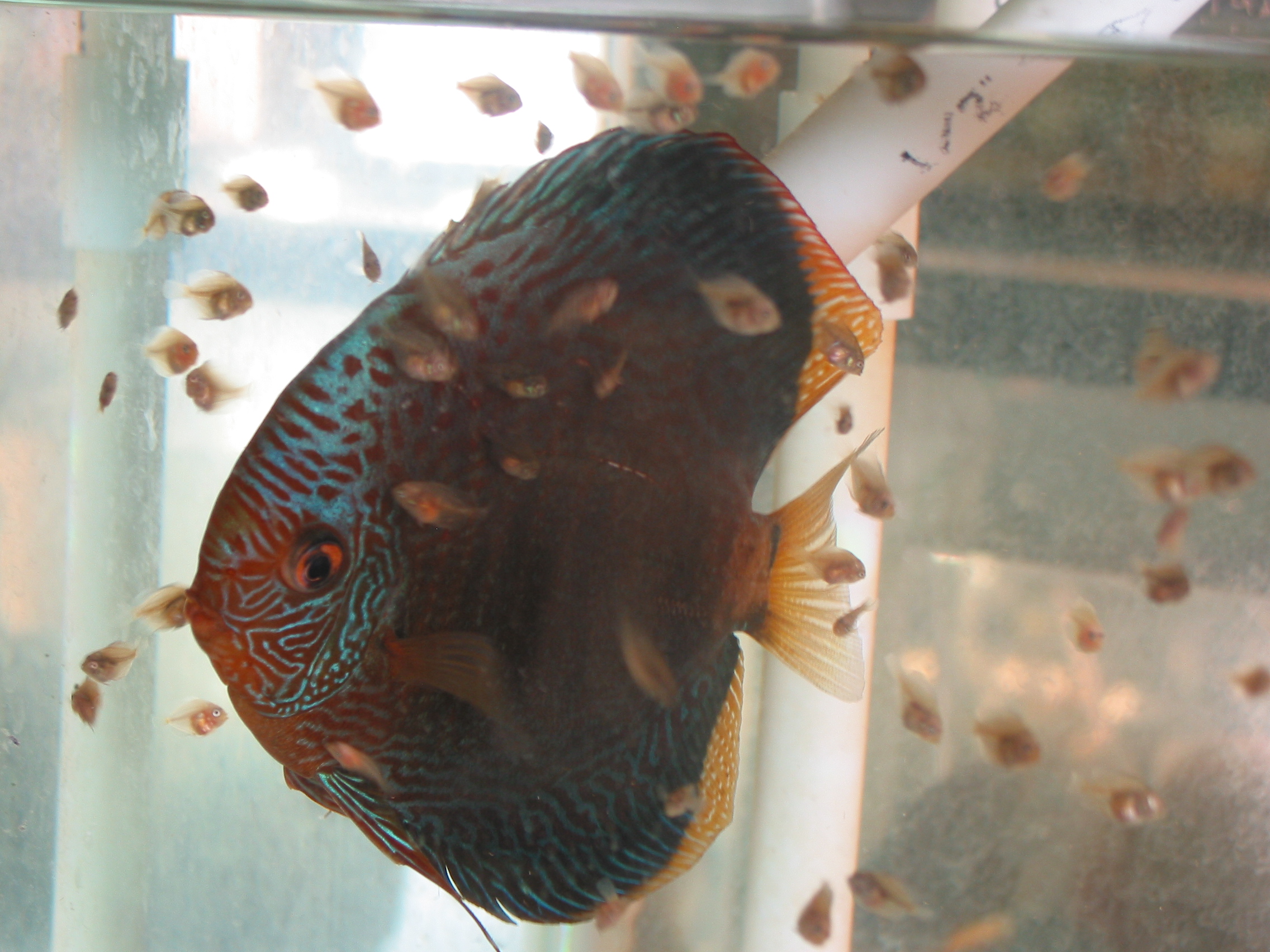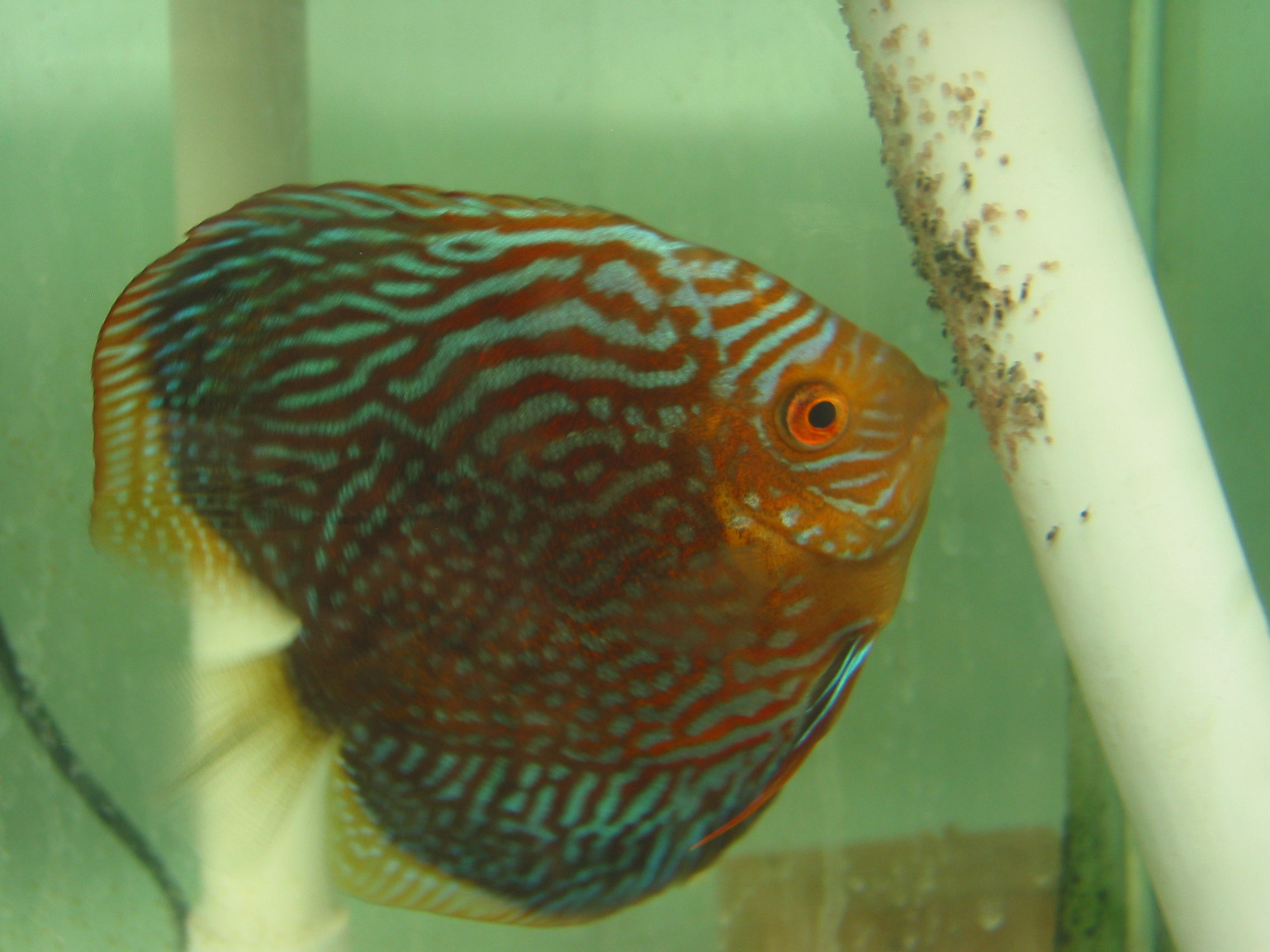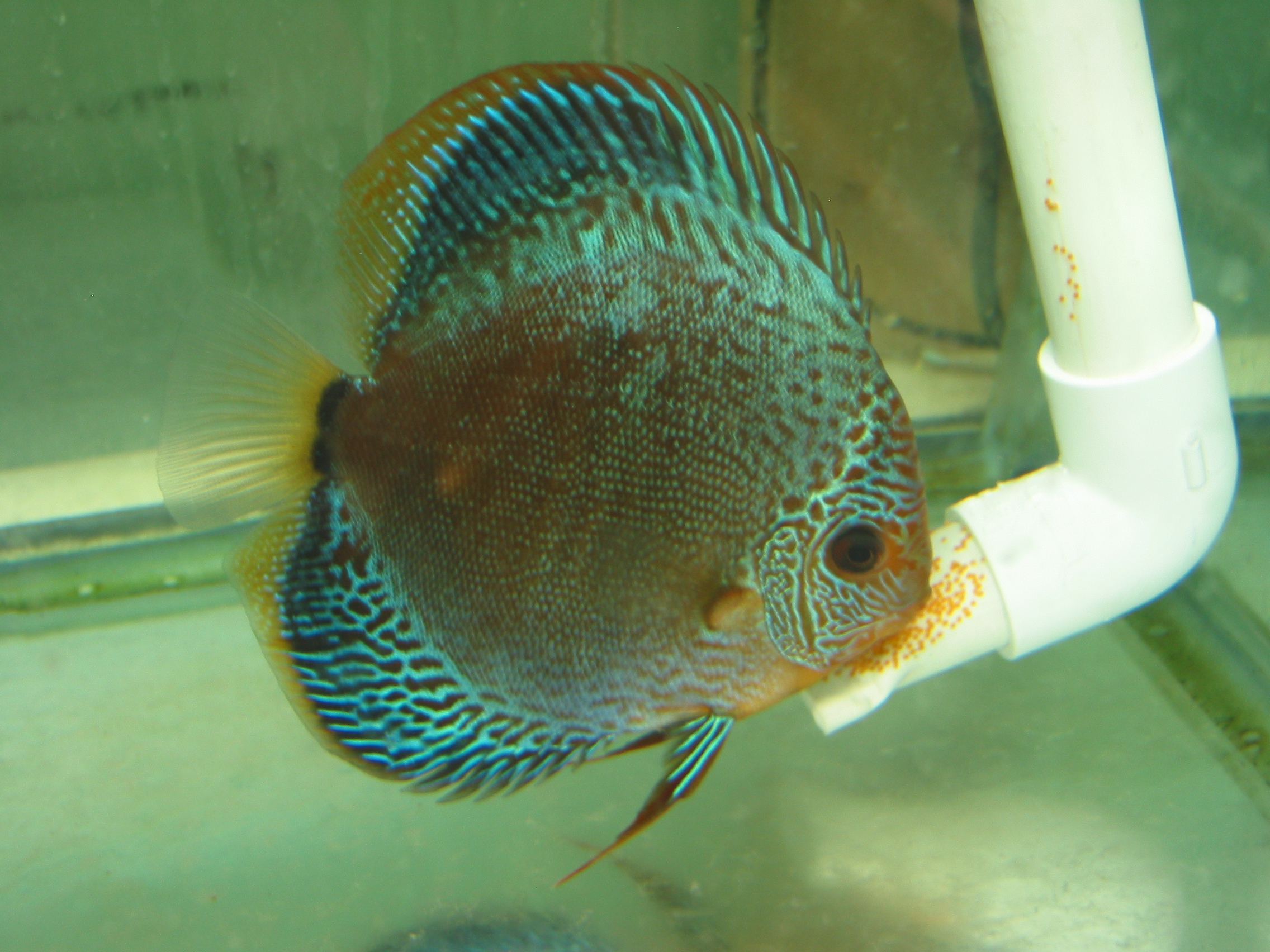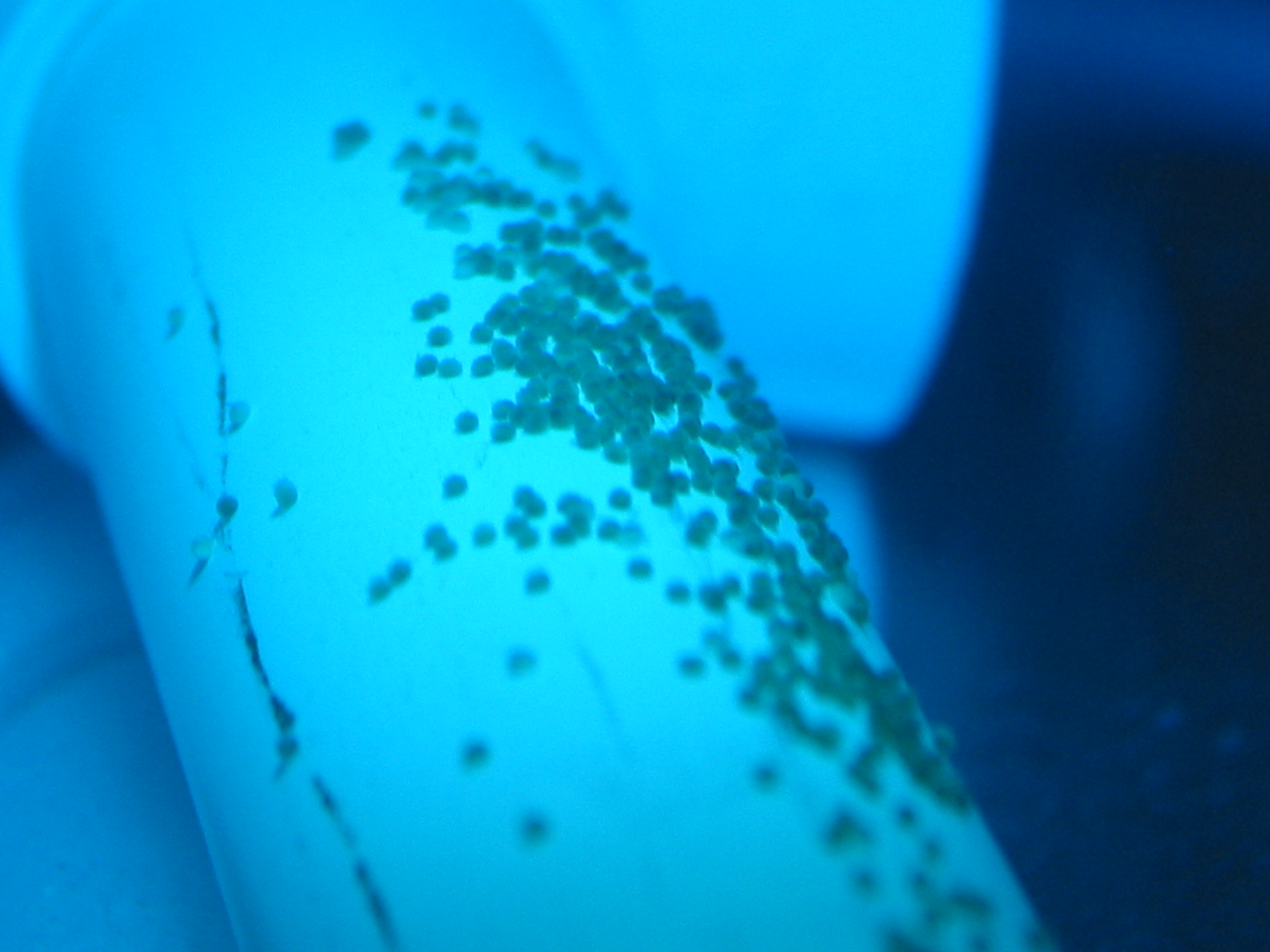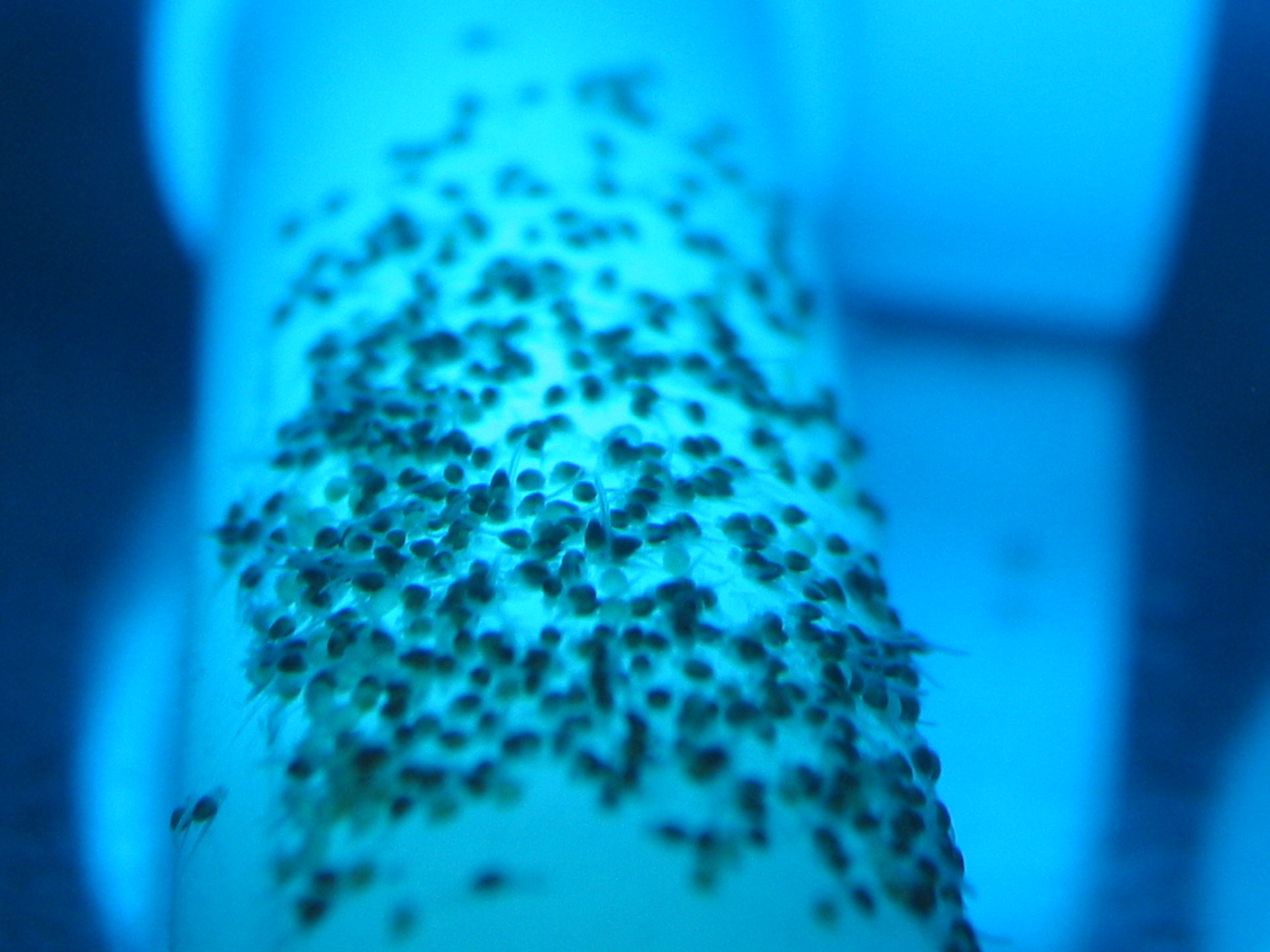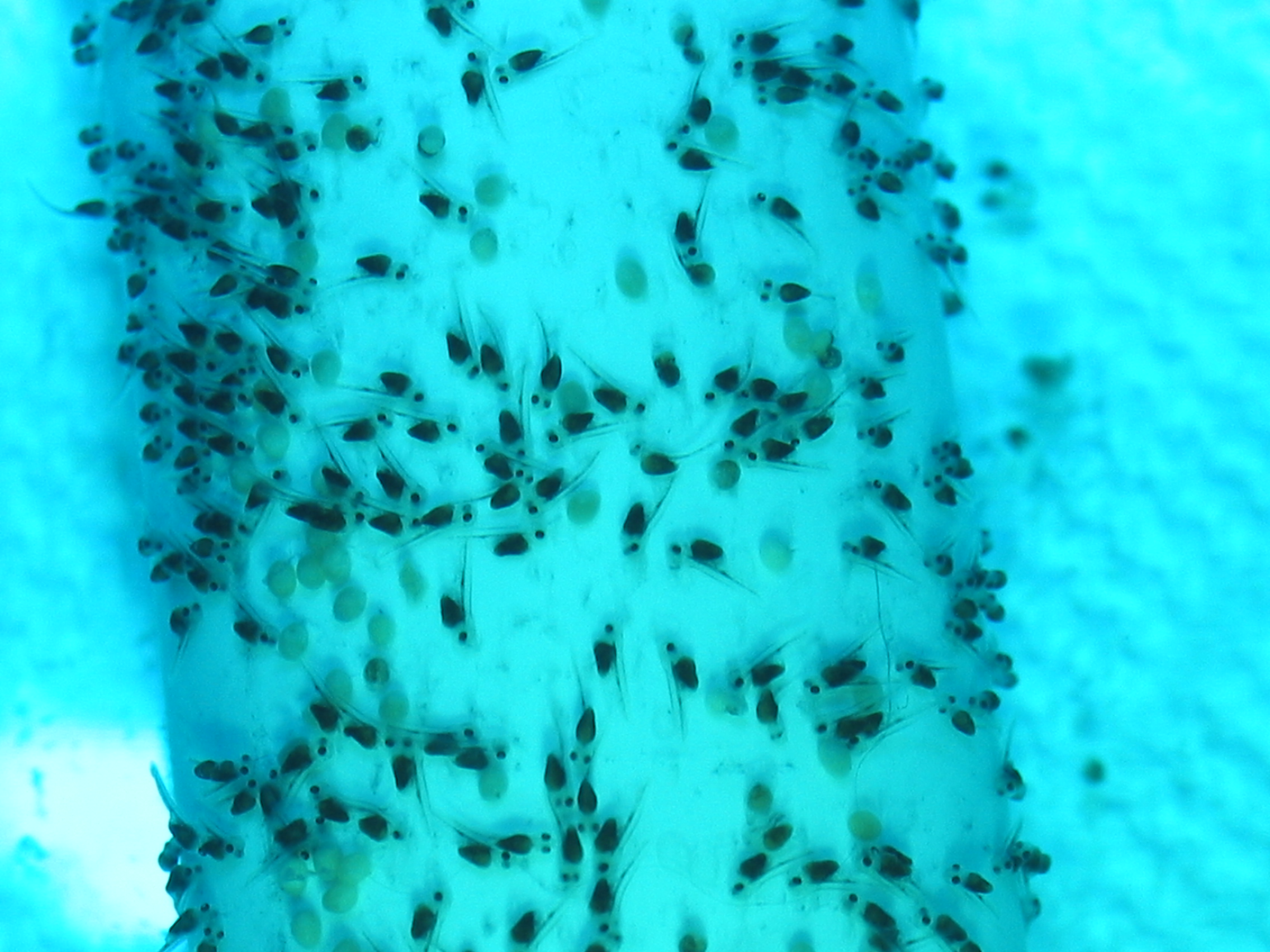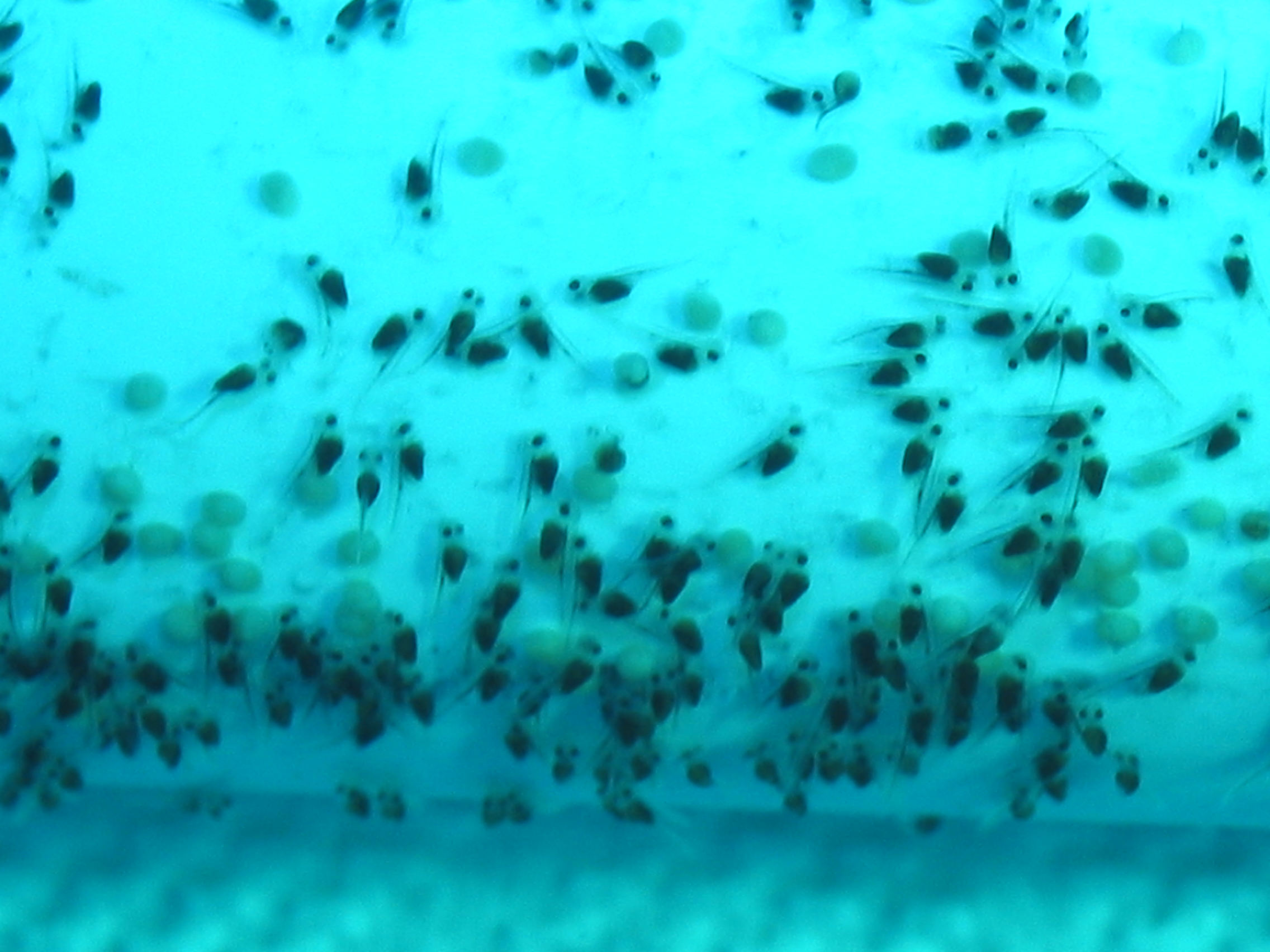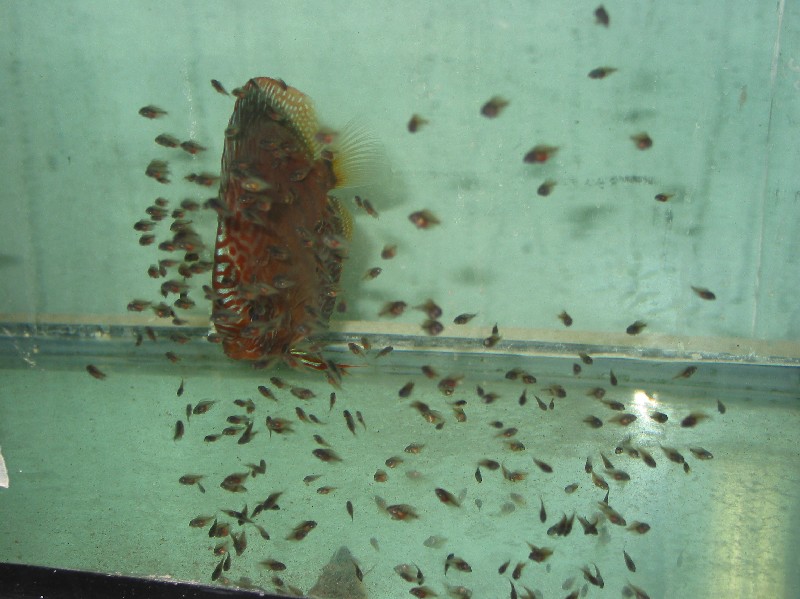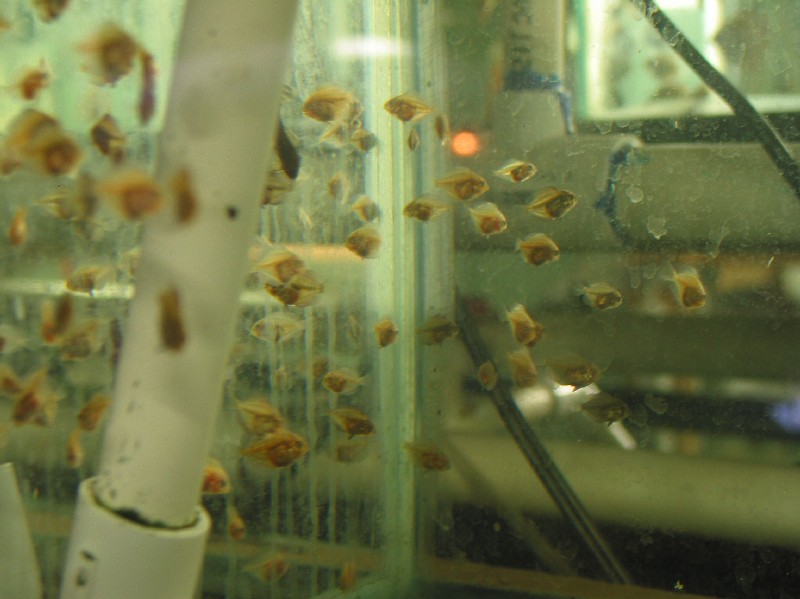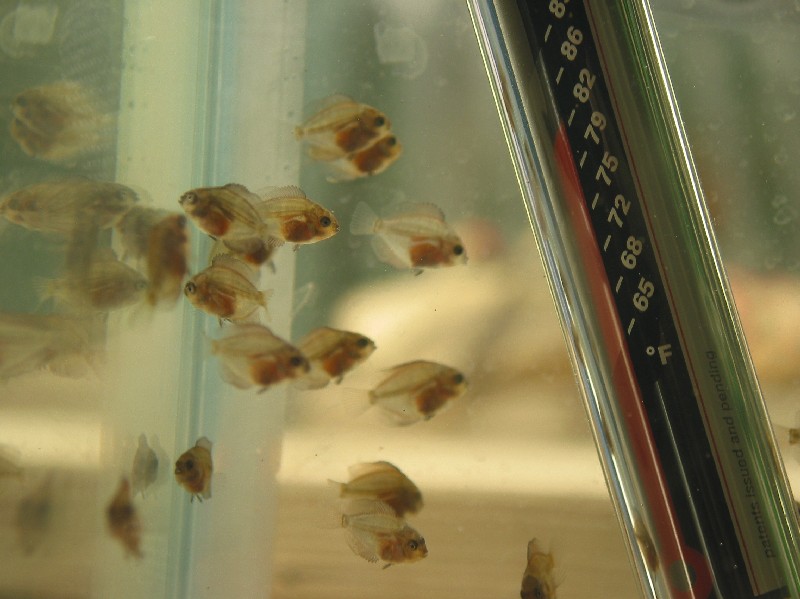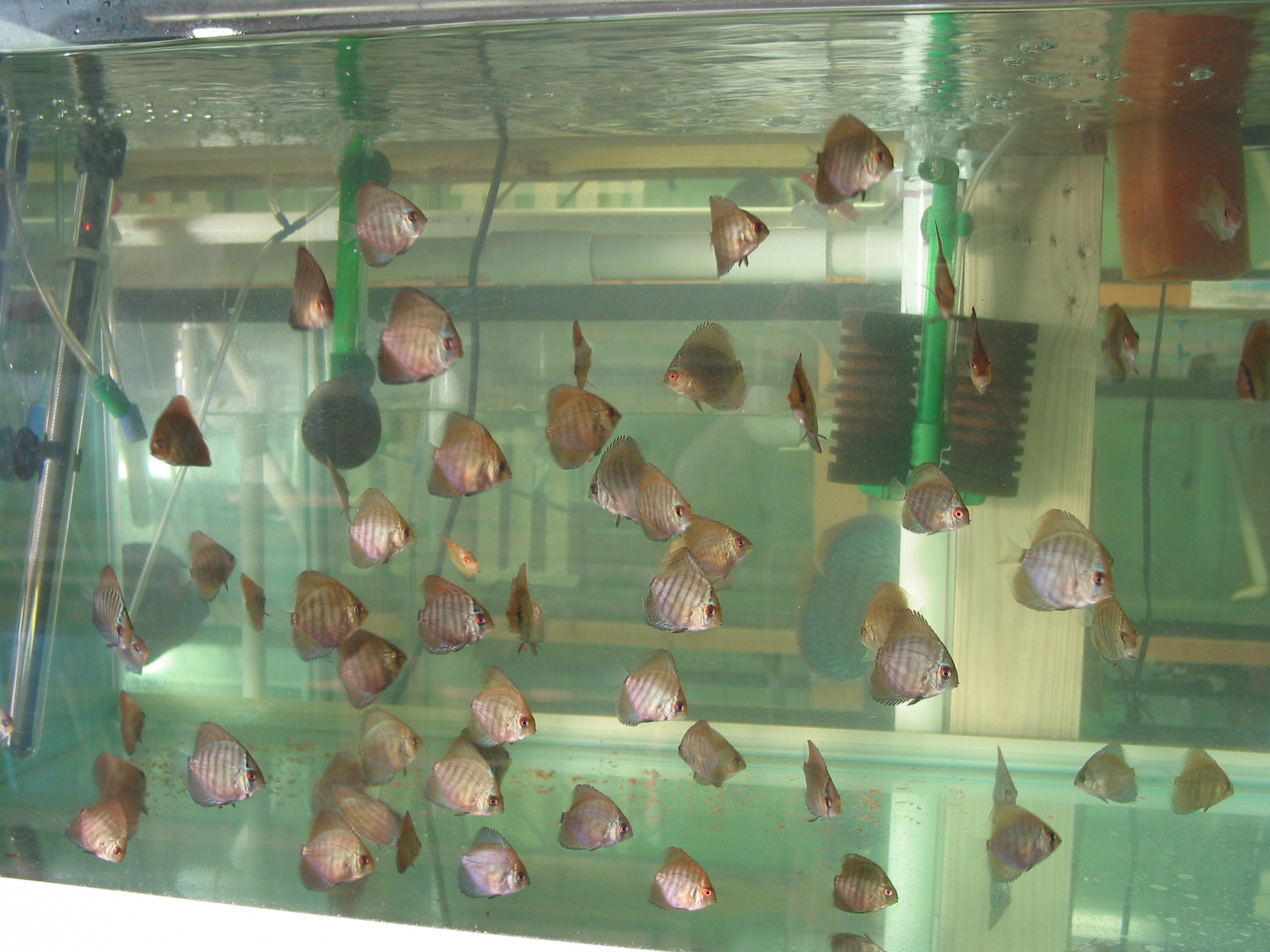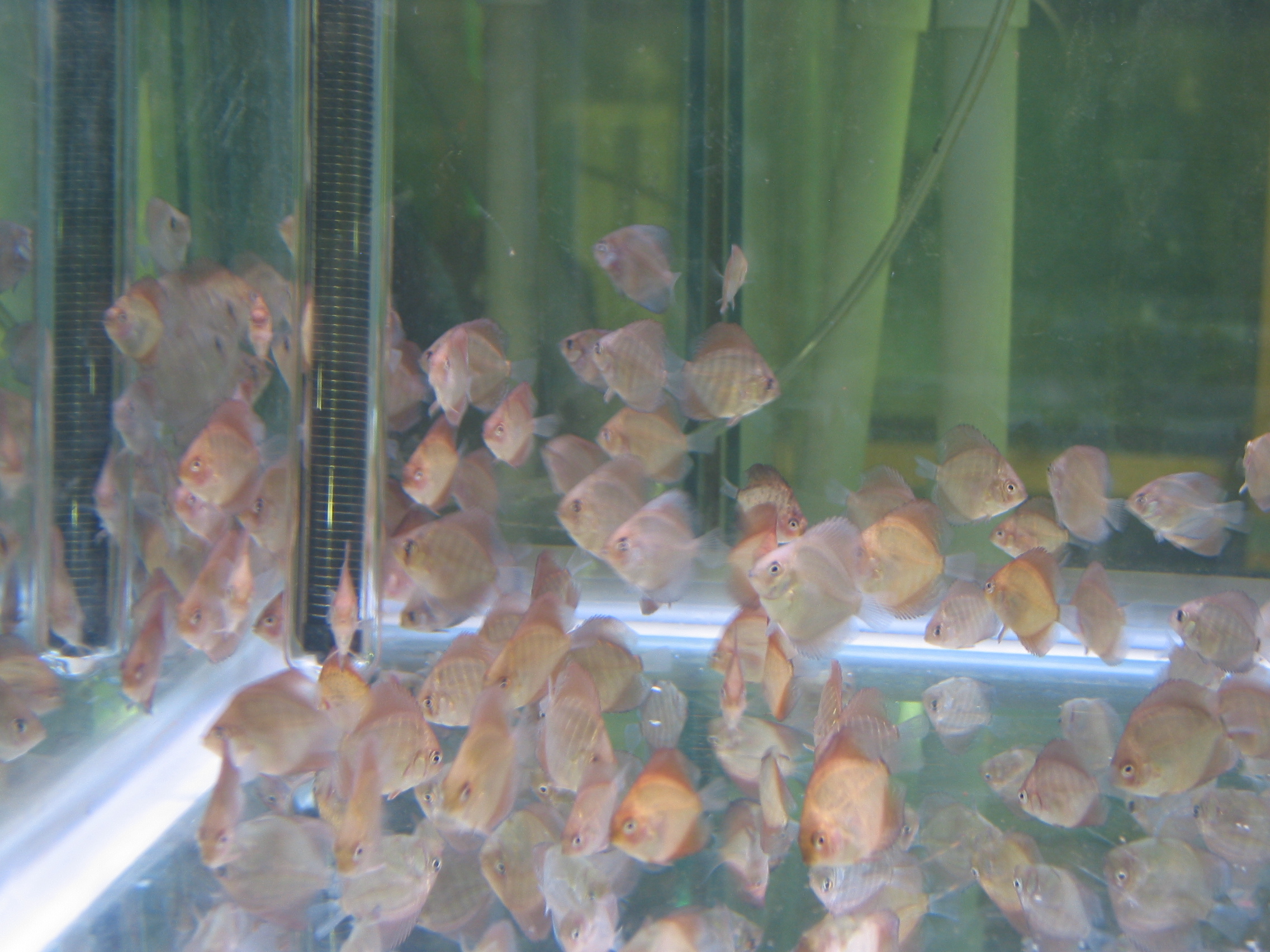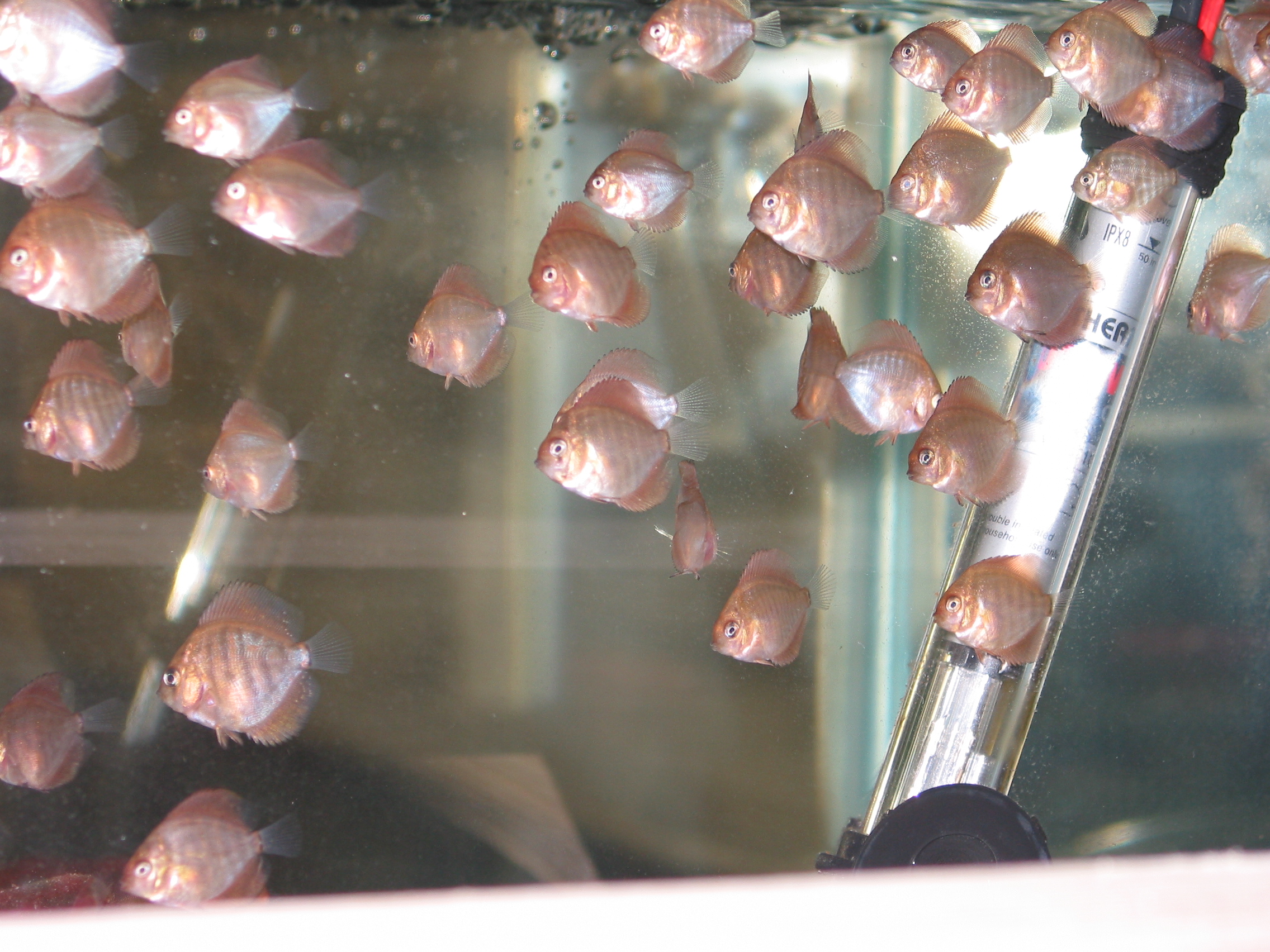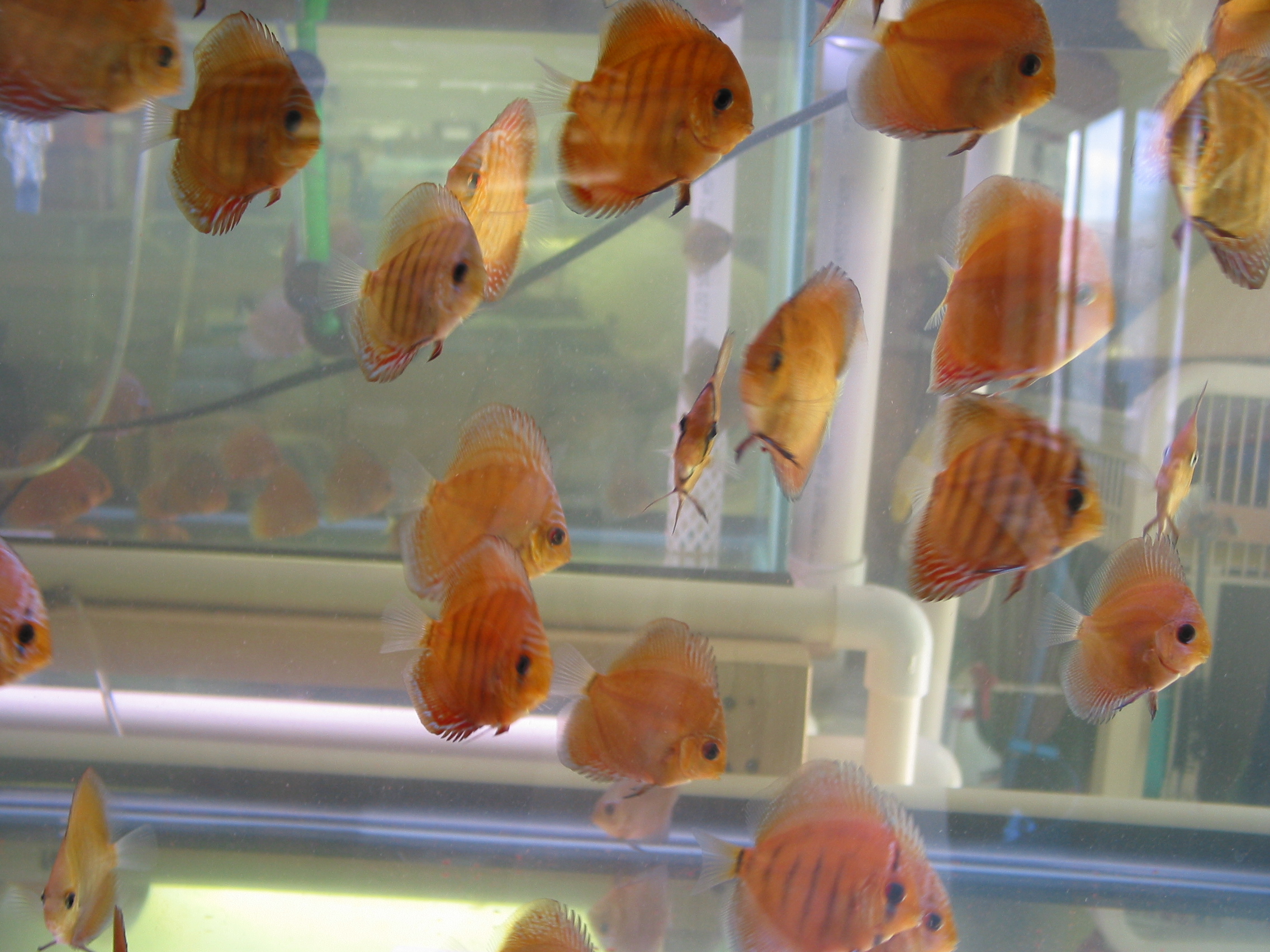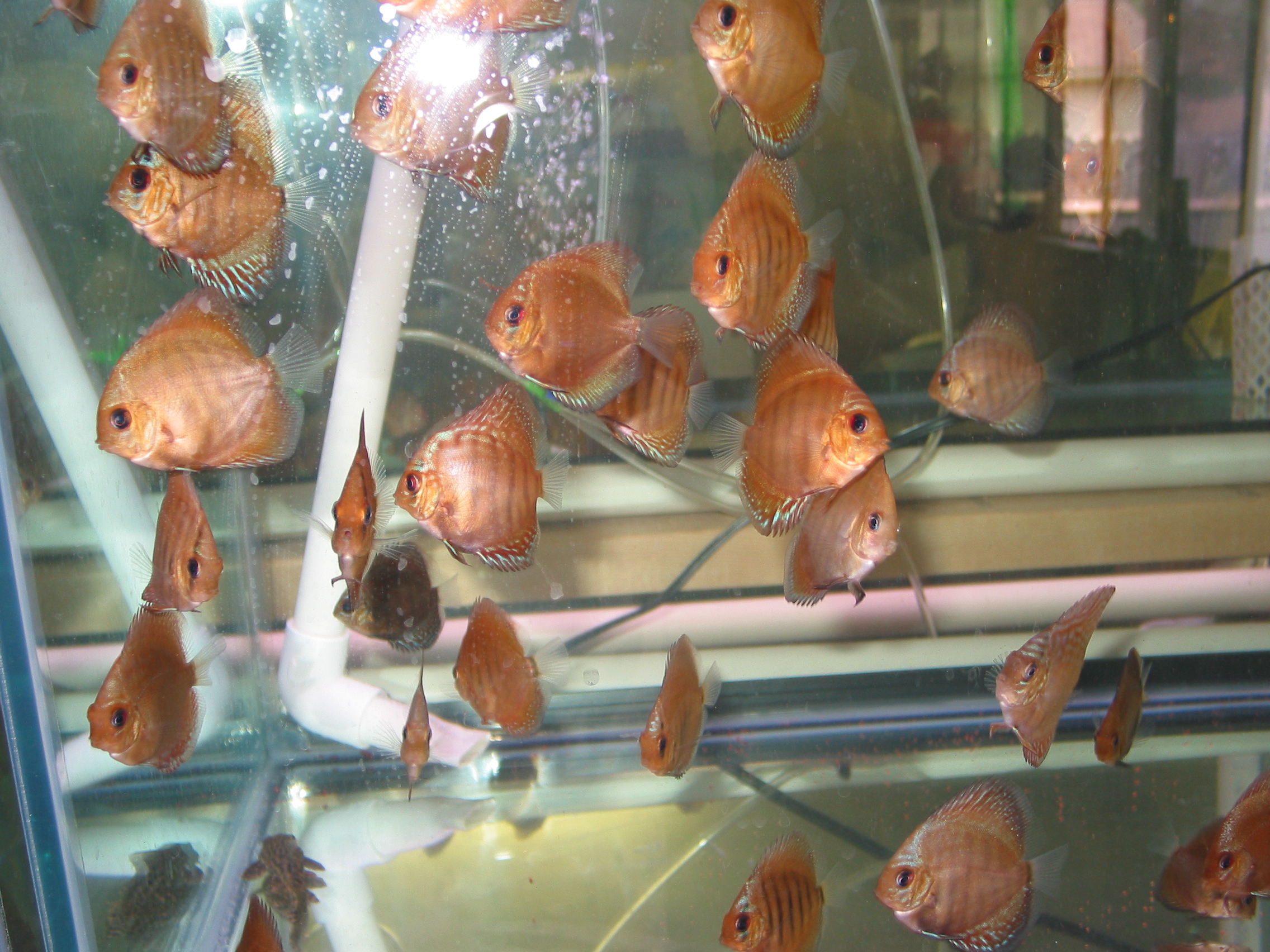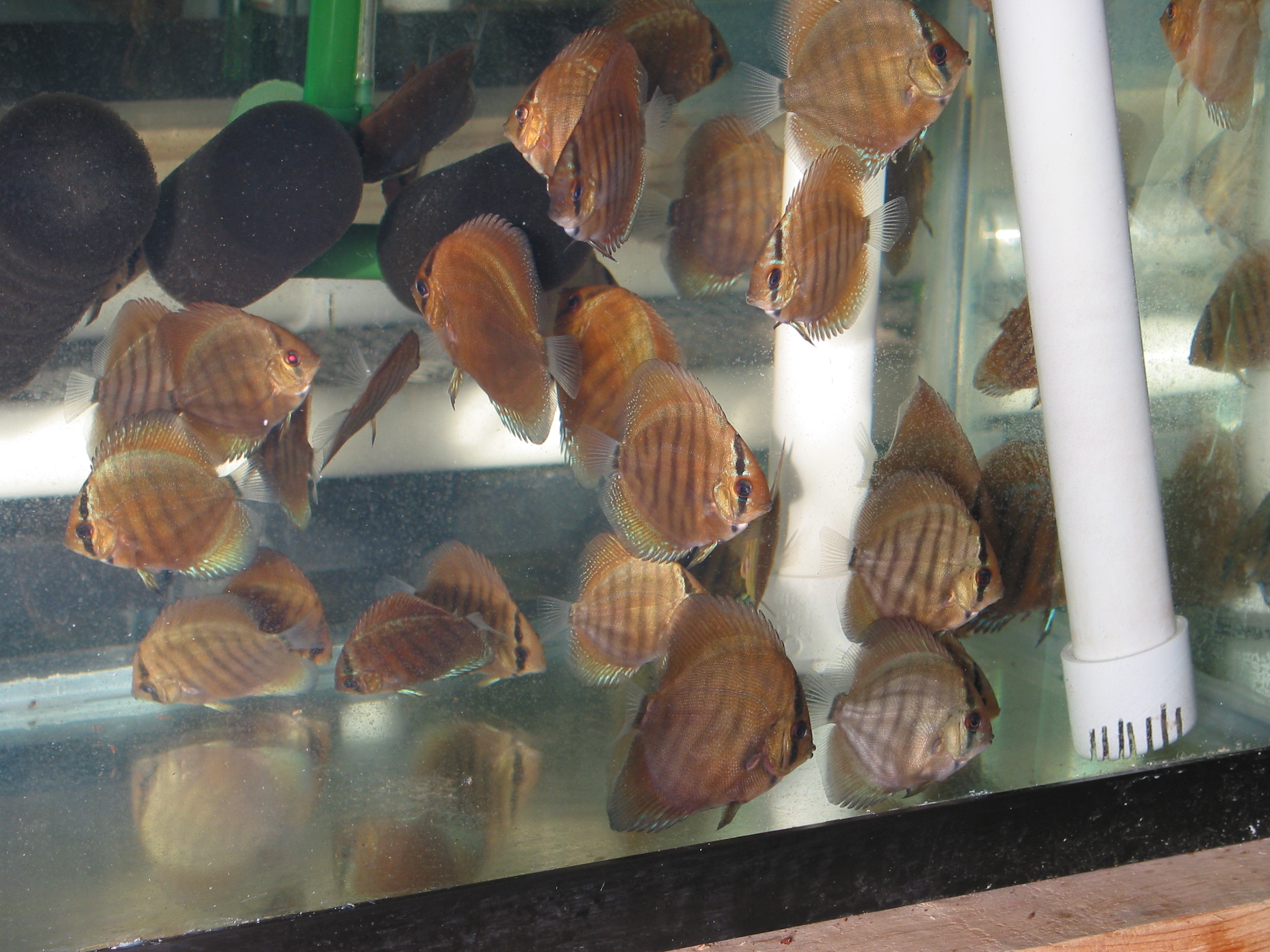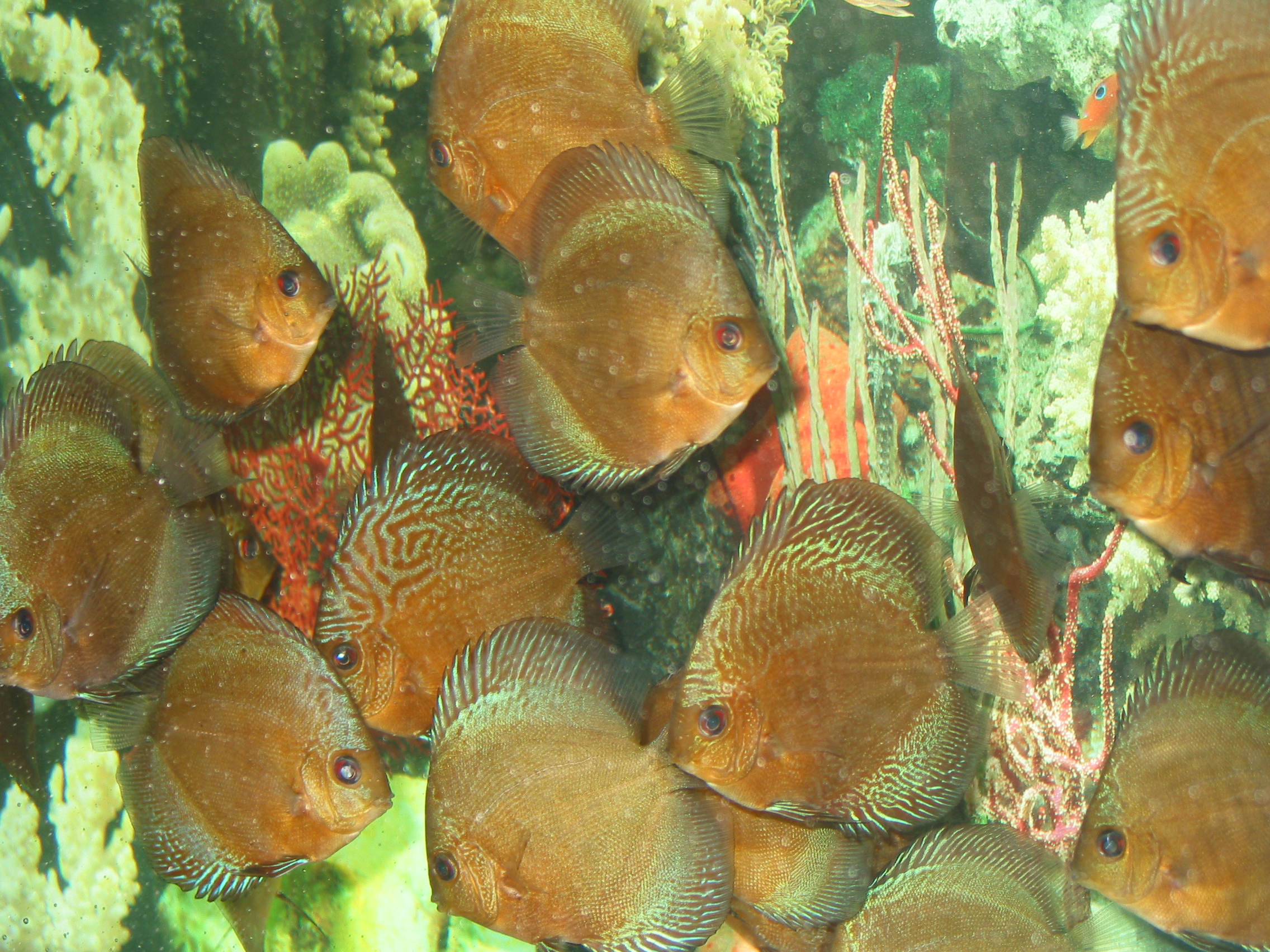Breeding
Our breeder pair are about 2-4 yrs old. Each pair are kept in its own 29 gallon tanks. We do not use breeding cones. They just lay their eggs on pvc plumbing. |
Discus Eggs and Fry
We add methylene blue to our freshly laid eggs to protect against fungi. New hatchling are raise by the parents. They feed on the slime coat of the adult fish. Once they are slightly larger, we start to feed them newly hatched brine shrimp. As for raising artificially, we have not had any luck with them. It’s very time consuming and our yield per spawn did not increase significantly to use this technique. (Click on (picture for larger image) |
Youngs
After 10-14 days with the parents, fries are moved to 10-30 gallon tanks. They are fed multiple times throughout the day for fast growth. About 10-20% water change are done daily after the last meal. After 2 months, they are moved to 55-125 gallon grow out tanks. |
Feedings
We feed our young/adult discus many varieties of food, including Hikari Discus Color Enhancer, Tetra Colorbits, brine shrimp/garlic flakes, Live daphnia, and blood worms. Therefore, our discus will be accustom to many types of food. Most of our customers have no problems with our fish not eating. Feeding are done at least three times a day to fast growth. We do not use any hormone feeding or sell any hormone fed fish. We feed our sick and not eating discus live daphnia or frozen blood worms. They will usually won’t eat anything else. These fish will recover once they start eating after treatment. Our baby fries are feed on newly hatch brine shrimps until they are able to take larger foods. Feeding are 3-4 times a day. Slightly larger fries (3-4 weeks old) are feed with live Daphnia pulex, and Moina, both are smaller the Daphnia magna. Then started on foods stated above. |
Water Parameters
Our discus water are pH 6.0-7.8, and use only regular tap water without using R/O. We do not check our water hardness. Temperature are set at 82 F. We change 30% water every four days. Our tanks are all interconnected into seven filter systems with filters placed inside our sumps. These filters are clean daily. pH is adjusted down with Seachem pH buffer and up with baking soda. Please make sure you have the similar water parameters before ordering. Biological filters are provided by sponge filters in each tank and Biosubstrates(bioballs, biospheres, etc) in sumps. Sponge filters are cleaned regularly, but half are cleaned at a time to preserve the biological system. |
Diseases
There are some many ways to prevent and treat discus diseases. The following are just what works for us. We usually try to keep things simple. Prevention The only prevention we use are garlic in beef heart mix for internal parasites (hexamita, etc.) Discus are very easily infected with parasites (wasting away and white feces.) Prevention is key with internal parasites. Other things are just to keep the water condition in stable range, feeding varieties of foods, etc. All new fish that we get are quarantine for at least 3 weeks and monitored for diseases. To sterilize equipments (i.e. tanks, nets, etc), we use regular household bleach. Rinse thoroughly afterward. Treatments First, we will increase the water temperature to 86-88 F. Also, a higher ratio water change is done before treatment. The following are the medications that we use. These methods may not be the best, but it works for us.
Other disease that we have no success with treatments are swim bladder type of diseases. We are lucky in that discus plague has not been a problem (knock on wood). |
Tank Setup
Discus needs lots of room to grow to its maximum size. The bigger the tank setup the better. Water conditions are harder to maintain in an overloaded fish tank. This will lead to increase stress and stunting of fish. Therefore, the minimum tank size recommended for discus is a 55 gallon tank. As a rule most hobbyist follows, one adult discus will need about 10 gallon of water. More fish could be kept, but more frequent water changes and cleaning of filters are needed. For a beginner, we recommend 6-8 small discus for a 55 gallon tank. Discus tank setups can be divided into two types, planted discus tank and bare bottom discus tank. Each have its own advantages and disadvantages. Bare bottom tanks are mostly preferred by breeders and some serious discus keeper, including ourselves. These setups only have an air stone or power head for circulation and sponge filter for biological filtration. The advantages to this setup are that its easy, and simple to clean/maintain; fish can be fed heavily, uneaten food will not be trap in gravel; fish will not shy away because they have nothing to hide; and relatively inexpensive to setup. Disadvantages are that setup looks less presentable and plants cannot be kept. As for planted tanks. The advantages are more artistically pleasing to look at; ability to keep plants; and if setup correctly, more biological balance cycle. The disadvantages are that its maintenance are more difficult; heavy feeding cannot be done; and more skills are needed (i.e. CO2 injectors, lighting, etc); medications cannot be administer without affecting plants; and cost more to setup. We do not recommend beginners to start out with planted discus tanks unless they have previously kept planted tanks. Tank mates for discus would be any fish that are not aggressive or over complete with discus for food. An Amazon tank setting would be excellent for discus. Fish that would be compatible are small tetras (neon, cardinals, glow lights, etc), German rams, corydoras, etc. Angelfish are not good tank mates because they usually compete with discus. |

